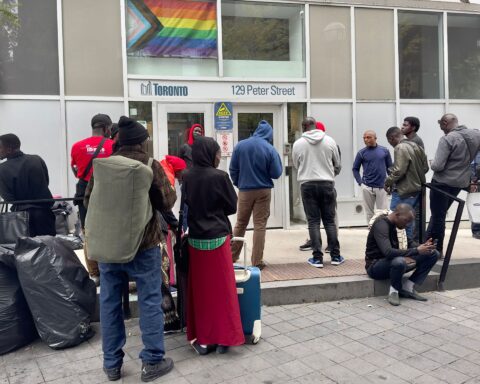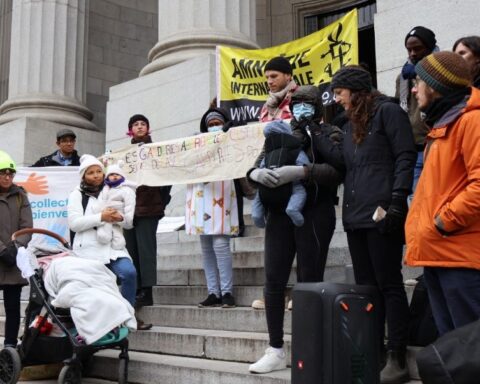May 2009, the civil war in Sri Lanka was grinding its way to an excruciating end.
Government forces were in a decisive push against the separatist Liberation Tigers of Tamil Eelam (LTTE) after more than 25 years of bitter fighting.
Caught in the crossfire were thousands of Tamil civilians, but governments around the world were stoic about human suffering despite blatant rights violations by both sides in the conflict.
The LTTE’s terror tactics had increasingly alienated them from the Tamil cause for an independent homeland.
This forced the Sri Lankan Tamil diaspora, by now scattered across the globe due to the war, to take to the streets to bring attention to the suffering.
[G]overnments around the world were stoic about human suffering despite blatant rights violations by both sides in the conflict.
With Canada being home to the largest Sri Lankan Tamil population outside of the island nation, diaspora activism was at its peak here. They had been demonstrating since December 2008 and their protests in various cities had almost become routine by May.
But Canadians were ambivalent about a minority community protesting about a conflict happening far away from them. The display of the flag of the LTTE, by now a proscribed terrorist organization, also did not help in the battle for the hearts and minds.
So, even as the LTTE fighters were making their last ditch stand in Sri Lanka, the public relations battle in Canada was lost by the evening of May 10.
As dusk fell that Sunday night, several thousand Tamil protesters swarmed the elevated Gardiner Expressway. A crucial artery for downtown Toronto, it was effectively shut down till about midnight.
Anecdotes abound about how those caught in the traffic chaos suffered on that day. That it also happened to be Mother’s Day, and many were prevented from visiting their families, dealt the final blow in the court of public opinion.
It took the Tamil community several years to repair the damage done.
It took the Tamil community several years to repair the damage done.
But how did a community, that began gaining critical mass in the early 1980s, start organizing themselves on such a large scale?
Scholarly scrutiny
The answer to this question can be found in Pain, Pride, and Politics, a recently released book by Amarnath Amarasingam.
The genesis of diaspora activism specific to Sri Lankan Tamils forms the core of this book as it delves into an issue that needed scholarly scrutiny.
Until now we only had a crude understanding of this diaspora, its struggles and successes, and more importantly its links to the civil war.
A post-doctoral fellow in the Resilience Research Centre at Dalhousie University, Amarasingam weaves together a narrative that give us an insider’s view with the studied detachment of an academic.
However, the author’s lived experience as a young Tamil growing up in Toronto informs what would have otherwise become too academic. This is evident right from the introduction when he describes an encounter with the LTTE’s infamous money collectors in front of his home in the early 1990s.
‘Big egos, short fuses’
Amarasingam acknowledges that many Tamils did indeed give willingly and generously to these collectors every month. However, for others, they were an ever-present nuisance: “young men with big egos equipped with dangerously short fuses,” the author writes.
And it was not just the diaspora Tamils who grew weary and concerned by the LTTE’s presence and activity.
Governmental and policy circles started seeing Tamils as … fundamentally corrosive to the prospects of peace in Sri Lanka.
Soon the whole community got tainted in the eyes of mainstream Canada. Governmental and policy circles started seeing Tamils as overly radical and fundamentally corrosive to the prospects of peace in Sri Lanka.
Although some of these concerns were perhaps justified, much of the anxiety was exaggerated by misunderstandings.
This book now provides an in-depth examination of the ways in which a separatist socio-political movement has been carried forward, altered and adapted by the diaspora.
To make sense of this process, its first chapter examines the rise and fall of Tamil militancy in Sri Lanka. It gives a detailed account of how ethnic grievances, political mobilisation, and events on the island led to armed conflict.
The focus then shifts to diaspora activism in Canada. The book comes into its own here as it attempts to fill two broad gaps in literature on diaspora politics.
Peace or trouble makers?
First, much of the writings examine diaspora communities as either peacemakers or troublemakers in relation to conflicts in their old countries. This black and white approach fails to acknowledge the greys of diaspora activism in its own right.
Second, in setting out to address this issue, Amarasingam cross-fertilizes his diaspora study with extensive literature on social movement theory.
It helps us better understand the street protests, the organizational dynamics and the process of identity formation in the post-civil war Tamil diaspora.
The futility of dividing the community between a “moderate majority” and a “pro LTTE bloc” is also brought forth.
Understanding future diaspora groups
Even though Pain, Pride, and Politics is the first such book-length treatment of Tamil diaspora politics in Canada, it does have self-set boundaries.
With 25,000 refugees from Syria to soon settle across Canada, this treatise on a group that came here under very similar circumstances is very opportune.
Issues like inter-generational religious identity, the proliferation of temples and ethnic Tamil churches, debates about caste identity, refugee experiences, mental health issues affecting the community and gang violence are not touched upon.
By skimming on these diaspora issues and a fuller account of post-colonial political developments in Sri Lanka, maybe Amarasingam is setting himself up for another book in the future.
But what he gives us in the present is a periscopic view of the singular dynamics that propel diasporic communities into uncharted spaces.
With 25,000 refugees from Syria to soon settle across Canada, this treatise on a group that came here under very similar circumstances is very opportune.
The insights offered make it an essential read for understanding the struggles future diaspora groups are likely to face and maybe even for helping us mitigate or prevent some altogether.
Ranjit Bhaskar is a Toronto-based journalist and writer with a keen interest in Canadian politics and immigration and South Asia.
Ranjit is a Toronto-based writer with interest in Canadian civic affairs, immigration, the environment and motoring. Maytree and Al Jazzera English alumnus.





